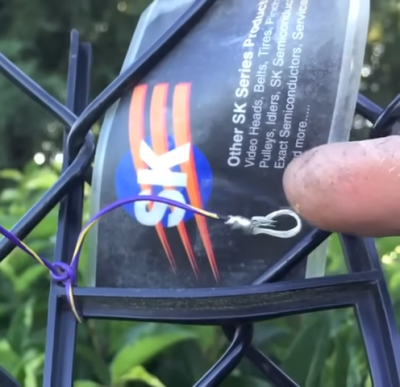Most hams can tell you that it’s possible to get a nasty RF burn if you accidentally touch an antenna while it’s transmitting. However, you can also cop a nasty surprise on the receiving end if you’re not careful, as explained in a video from [Grants Pass TV Repair].

An experiment was used to demonstrate this fact involving a kite and a local AM broadcaster. A simple calculation revealed that an antenna 368 feet and 6 inches long would be resonant with the KAJO Radio signal at 1.270 MHz. At half the signal’s wavelength, an antenna that long would capture plenty of energy from the nearby broadcast antenna.
Enter the kite, which served as a skyhook to loft an antenna that long. With the wire in the air picking up a strong signal from the AM radio tower, it was possible to get a noticable RF burn simply by touching the end of the antenna.
The video explains that this is a risky experiment, but not only because of the risk of RF burn itself. It’s also easy to accidentally get a kite tangled in power lines, or to see it struck by lightning, both of which would create far greater injuries than the mild RF burn seen in the video. In any case, even if you know what you’re doing, you have to be careful when you’re going out of your way to do something dangerous in the first place.
AM radio towers aren’t to be messed with; they’ve got big power flowing. Video after the break.

















Make a hot-dog talk using an AM broadcast station – another one from Geerling Engineering: https://www.youtube.com/watch?v=GgDxXDV4_hc
First, it’s not a good idea to suspend an antenna with the kite directly attached to the wire. Use good kite line, something light and strong like Dacron line. And then suspend your antenna from that. You could attach a metal ring with a lark’s head knot and then hook the antenna from there.
That said, it’s not just RF burns that you have to worry about. Note that he was not very far away from the radio station and using a resonant half wave line. It’s also static electricity. You do not need to be near a thunderstorm to accumulate a lot of static electricity. Many years ago, a good friend of mine and I were flying kites behind his boat for use on the HF bands. It was a bright sunny day with just a very few scattered clouds. We lofted about 300′ of wire-wrapping wire as an antenna line. We were about to attach it to the antenna tuner. One of the guys picked up the loose antenna line and the static shock literally knocked him across the deck of the boat. We could hear a faint tick tick tick and didn’t realize in the bright sunlight that this was static electricity arcing to a grounded handrail.
So if you’re determined to try anything like this, keep the ground of the line, grounded. Use an RF choke or a high value resistor to ground to bleed off the charge. Safety First…
Yep.
It varies greatly, but the potential gradient in the atmosphere is substantial. On clear ground (or water) under blue sky, it will be over 100 volts per meter.
Stick a wire a hundred meters into the air and you can accumulate several kilovolts of potential. On the nanofarad or two of wire capacitance that length would have, you’d get a surprising zap. Not enough to knock you flat, but it would be startling.
Now, maybe your boat scenario was also picking up some tribolectric charges too, which might have given your friend the knock on his ass.
This reminds me of a post, from a few years back, about a project for pulling usable electricity from the atmosphere.
That sounds like an XKCD, “What if…?”
Yup,I ruined a good radio with just too much antenna conected to it, I should have used a 1:1 current balun and more grounding
Where does he get the 468 for the numerator of the wavelength calculation?
Is that including velocity factor?
What do you mean velocity? Like… the speed of light? Yes. Your wavelength is your velocity and frequency.
It seems to be a common magic number, but: speed of light ~300,000 km/s = 984,251,969 ft/s; call it 984 because dividing by MHz; /2 because it’s a dipole = 492; reduce by ~5% because it’s a wire not vacuum = 468. I think. Only used by Americans and oldies in the UK because everyone else is metric!
Yes I had to look it up because I was wondering too!
I’m currently studying for a UK HAM Foundation Licence and “300” is given as the magic number for speed of light when dealing with MHz and metric for dipoles and indeed, “468” was previously used that still think in cubits and inches.
It’s a common misconception among hams that the numerator should be 468. It’s not, but it’s reasonably close enough to keep the appliance operators from destroying their equipment. Most hams that are tinkering with antenna building know better. QST did an interesting article about the subject awhile back.
When cutting antenna wire to half wave length I use 492 and it works better (IMO) and trim/tune from there, it’s easier to cut a little off than to put it back on
The hams that I know do use metric.
As a rule of thumb, that’s 300÷Frequency (MC/s aka MHz)
For a Hertzian dipole (½ λ), it’s 300 ÷ MHz ÷ 2 · shortening factor
For old RG58CU coaxial cable, the factor 0,65 I think?
And wavelength (metre) can be used in place of frequency, too?
Not sure. I’m just an old CBer. 😅
Maybe adding or removing a quarter wavelength would help.
It may be in violation of the FCC regs. Placing a tuned element in the near field of the antenna tower could distort the station’s broadcast coverage area, which is specified in their license application.
I have done many kite projects for antenna and photography as well as fun, using many kinds of kites from deltas, sleds, parafoil, French military and Cody lifters and attached loads using mounts from simple knots to full picavet mounts.
I will second EVERYTHING that has been said and add this. Never under any circumstances should you use the antenna wire to fly the kite. The antenna wire should always have a break away, so if the kite gets loose it does not drag a hot wire behind it to harm innocent bystanders. Last thing you want is for it to cross a power line and hurt someone or worse.
When I use a kite-tenna, I always keep safety in mind, not just for myself but for everyone. If flying to high altitude I also notify the FAA. I have never had an issue calling the local tower and letting them know when I fly above typical kites.
To protect your radio you will need to ground through a 1M ohm resister and use a current balun. I usually also run a broadcast band filter to keep from overloading the frontend of the radio. I also like to try to have my antenna as vertical as possible so I will often fly the kite well above the mounting point and the anchor will be behind my operator position. The best way I have found to attach the antenna to the kite string is using a length of stretch cord, like what you might find at a fabric store.
You will also need to learn what size kites to fly for the conditions. It is very easy to underestimate the lifting and pulling power of a kite. You don’t want to fly a train of Cody lifters in a strong wind, you may find the kites flying you!
73
A few years ago I lucked into a box of brand new mil surplus N-Type Huber & Suhner GDT EMP protectors which are good from DC – 2.5GHz but before that stroke of luck I used a spark gap made from an automotive spark plug.
I don’t live in a place where lighning is common but I have heard the sparkgap ‘ticking’ a few times.
“drag a hot wire behind it to harm innocent bystanders”
You will shoot your eye out.
Always has to be someone like above.
Yes I wear eye protection when I shoot, be it .177 bb’s to .50 BMG. I think you got it totally wrong, I am not critiquing the idea of the kite antenna, I have been flying antennas from kites for many years. My issue is with the execution in the video being extremely dangerous, not because of RF but because of power lines.
I’m going to assume you live somewhere that does not have overhead power lines. That is the only way I can imagine that you would have no concept of the danger a 80 – 100 meter wire flying around uncontrolled could create. In the United States residential overhead distribution electric line voltage is typically 7200V to ground, sub distribution is often 138-230KV, primary lines can run as high as 765KV. Kite line is made from non conductive material and will not create a significant risk if it comes into contact with power lines. However if the conductive antenna wire comes into contact with a power line I’m sure you can see the problem there.
Lifting kites are not like the toys you might be accustomed to flying, they can produce serious lifting and pulling power, often hundreds of pounds worth of force from a single kite. Aerodynamic forces multiply by the square of the velocity, so if the wind speed doubles the kite pulls 4X as hard. I have had instances where I set up a lifting system and the winds aloft were far higher than expected. It was a good thing to have a planned failure mode that created no risk.
If you are using a wire to fly a lifting kite like a parafoil, Cody, or French Military kite and the wind picks up do you know for certain where the wire is going to break, would you bet your life or others lives on it?
You may not have any concerns for yous or others safety or well-being but you should consider this. Even if you are a complete sociopathic monster, it is still in your best interest to practice the aforementioned procedure when flying an antenna from a kite (string). A person would face serious criminal and civil charges if someone was hurt or property was damaged because your kite got free with the wire attached.
Believe it or not there are things in this world that can hurt you or worse. There are some things that you can’t learn through experience because you don’t get a second chance, and real life does not have save points or a reset switch. I know so many snowflakes have grown up in a sanitized Disney fairytale, participation trophie, bumper padded world, so it is not entirely their fault that they have no concept of safety and risk mitigation. You have not seen soldiers “fallen” in a shower because someone messed up the pump wiring, I’m sure you have also not had the experience of a friend after an arc flash event begging you to call his wife to say goodbye, because he knew that he wasn’t going to survive the trip to the hospital. There are always risk in life, but no need to massively increase the odds by being arrogant and intellectually lazy. Some of my friends would still be here if someone took just a second to think about minimal safety precautions.
I usually look with a jaundiced eye at postings on the many user forums out there, some of which attempt to convey an air of sophistication. However, all the upvotes in the world can’t change the laws of physics. Just keep saying what you say. The experienced people will understand; you can only hope the less experienced have the intelligence to learn from others.
> Most hams can tell you that it’s possible to get a nasty RF burn if you accidentally touch an antenna while it’s transmitting.
This is the same principle used in electrosurgery. Wikipedia has a thorough article on the subject.